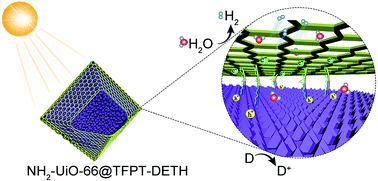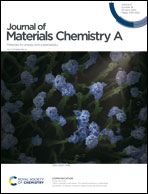In situ construction of hydrazone-linked COF-based core–shell hetero-frameworks for enhanced photocatalytic hydrogen evolution†
Abstract
Engineering hetero-frameworks by using organic frameworks is expected to be a novel and effective strategy to facilitate the charge separation efficiency of photocatalysts. Herein, we construct a metal–organic framework (MOF)@covalent organic framework (COF) core–shell hetero-framework via in situ growth of a hydrazone-linked COF (TFPT–DETH) on the surface of octahedral NH2-UiO-66. The resultant hetero-frameworks exhibit high specific surface area with the co-existence of micropores and mesopores, extended light absorption, as well as efficient exciton dissolution and transfer. The optimal sample with an appropriate shell thickness of about 20 nm achieves an excellent hydrogen evolution rate of up to 7178 μmol g−1 h−1, which is approximately 3 and 7 times that of pristine TFPT–DETH and its physically mixed counterpart, respectively. The concept of a hetero-framework structure may stimulate the rational design of heterostructured photocatalysts and enlarge the family of organic photocatalysts in solar energy conversion and utilization.

- This article is part of the themed collection: Journal of Materials Chemistry A Lunar New Year collection 2021


 Please wait while we load your content...
Please wait while we load your content...